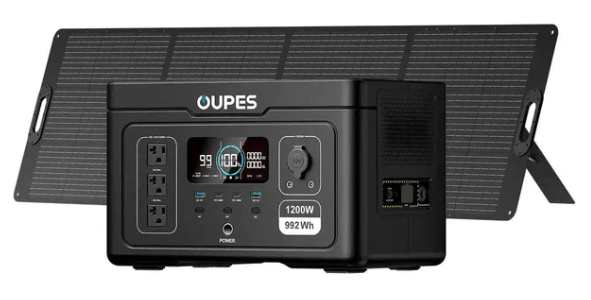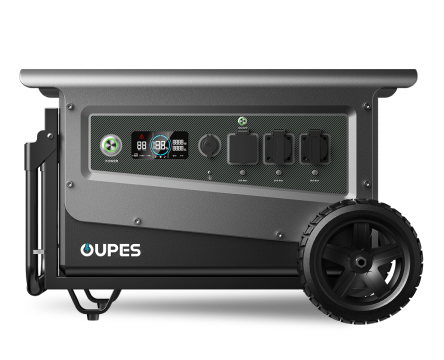
Table of Contents
- Introduction
- Understanding Full-Load Current
- The Formula for Calculating Full-Load Current
- Step-by-Step Calculation Examples
- Key Factors That Influence Current
- AC vs DC Systems: A Comparison
- Applying the Calculation to Portable Power Stations
- Safety Guidelines When Handling Electrical Loads
- FAQ
Introduction
When operating a solar generator or a portable power station, understanding how to calculate the full-load current is essential. This calculation tells you how much current flows through the device when it's delivering its maximum rated power. Knowing this helps prevent overloads, improve safety, and ensure you get the most efficient performance from your solar power system.
The U.S. Department of Energy emphasizes that accurate current calculations are crucial for maintaining stable and efficient off-grid systems, particularly when using battery-powered or inverter-based solar setups.
Understanding Full-Load Current
The full-load current is the maximum current that a generator or inverter draws when operating at its rated power output. It’s determined by the relationship between power, voltage, and efficiency. In simple terms, it indicates how hard your solar generator is working when fully loaded.
Main Factors Affecting Full-Load Current
- Power (P): The total rated output in watts.
- Voltage (V): The system’s working voltage (e.g., 12V, 24V, 48V).
- Efficiency (η): The conversion efficiency, usually between 85–95%.
- Power Factor (PF): Important in AC systems; typically between 0.8 and 1.0.
The Formula for Calculating Full-Load Current
To calculate full-load current, you can use one of two formulas — depending on whether the system operates with direct current (DC) or alternating current (AC).
1. DC Systems
I = P / (V × η)For example, if your 1000W portable power station runs on 12V with 90% efficiency:
I = 1000 / (12 × 0.9) = 92.6A2. AC Systems
I = P / (V × PF × η)For AC setups, you must include the power factor (PF). For a 2000W inverter running at 120V AC, PF of 0.9, and efficiency of 90%:
I = 2000 / (120 × 0.9 × 0.9) = 20.6AThis means the inverter requires about 20.6 amps at full capacity — useful information when sizing wires, fuses, or breakers.
Step-by-Step Calculation Examples
Example 1: 12V Portable Solar Generator
Imagine you own a solar generator rated for 1000W output at 12V DC with 90% efficiency.
I = 1000 / (12 × 0.9) = 92.6AThe generator must supply roughly 92 amps of current under a full load. You’d need thick, high-capacity cables (e.g., 2 AWG) to safely carry this current.
Example 2: 48V Solar Power Setup
Now consider a larger 2000W setup running on 48V with 92% efficiency:
I = 2000 / (48 × 0.92) = 45.3AHere, higher voltage reduces current draw, improving efficiency and minimizing heat loss in the cables.
Example 3: AC Output from a Portable Power Station
For a 1500W inverter at 120V AC with 0.9 power factor and 90% efficiency:
I = 1500 / (120 × 0.9 × 0.9) = 15.4AThe inverter delivers approximately 15 amps when fully loaded, which helps determine compatible appliances and load management.
Key Factors That Influence Current
1. System Voltage
Higher voltage reduces current for the same power output. That’s why 48V systems are more efficient than 12V — they minimize line losses.
2. Efficiency Losses
All inverters and charge controllers lose some power as heat. A 90% efficient inverter wastes 10% of its input energy.
3. Power Factor (PF)
Appliances with motors or compressors, such as refrigerators, typically have a PF below 1.0, drawing more current than resistive loads.
4. Ambient Temperature
High heat increases wire resistance and can slightly alter current values under constant power demand.
AC vs DC Systems: A Comparison
| Parameter | DC System | AC System |
|---|---|---|
| Formula | I = P / (V × η) | I = P / (V × PF × η) |
| Power Factor | Not applicable | Usually 0.8–1.0 |
| Current Flow | Unidirectional | Alternating |
| Typical Voltage | 12V, 24V, 48V | 110V, 220V |
| Losses | Higher cable loss | Lower transmission loss |
| Best Use Case | Portable power stations, RVs | Home inverters, grid-tied systems |
Applying the Calculation to Portable Power Stations
Portable solar generators and power stations combine batteries, inverters, and controllers into one integrated unit. Knowing the full-load current helps users plan how many appliances can safely run at once.
Example: A 1000W Portable Power Station
At 110V AC with 90% inverter efficiency and PF = 1:
I = 1000 / (110 × 0.9) = 10.1AThis means the device can power appliances totaling up to about 10 amps of continuous draw. For example, a 500W fridge (≈4.5A) and a 300W laptop setup (≈2.7A) could run together safely.
Brands like OUPES integrate MPPT technology in their power stations, automatically adjusting current for maximum solar charging efficiency — ideal for off-grid users and RV enthusiasts.
Safety Guidelines When Handling Electrical Loads
1. Choose Proper Cables and Connectors
Use cables thick enough to handle full-load current. Undersized wires cause voltage drop and overheating. Refer to the American Wire Gauge (AWG) standard for safe sizing.
2. Install Correct Fuse Ratings
Fuses should be rated at least 125% of the system’s full-load current to prevent damage during short surges.
3. Avoid Continuous Overloading
Running the generator above its rated load can overheat internal components, shortening lifespan. Always keep usage below 90% of maximum capacity for continuous operation.
4. Ensure Adequate Ventilation
Solar generators and power stations should be used in well-ventilated areas to dissipate heat safely.
FAQ
1. What is the difference between rated and full-load current?
Rated current is the nominal operating current; full-load current is the maximum safe current when running at 100% power output.
2. Can I use the same formula for both AC and DC systems?
Yes, but for AC you must include the power factor (PF) because of reactive loads.
3. Does efficiency really make a big difference?
Absolutely. A 90% efficient inverter draws 10% more current than a perfect one, which can affect cable sizing and battery runtime.
4. What happens if the current exceeds the limit?
Overcurrent can trip breakers, melt wires, or damage the inverter. Quality systems with built-in protection — like those from OUPES — automatically shut down before that happens.
5. How do I measure the current directly?
Use a clamp ammeter or multimeter on the output line while the generator is running near full capacity.
6. Why does voltage affect current?
They’re inversely related: at higher voltage, less current is needed to deliver the same power, reducing cable loss and heat.




























